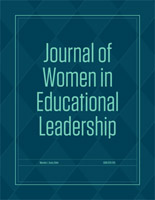Educational Administration, Department of

Journal of Women in Educational Leadership
Date of this Version
7-2008
Document Type
Article
Citation
Journal of Women in Educational Leadership, Vol. 6, No.3-July 2008 ISSN: 1541-6224
Abstract
Previous research has shown that a variety of skills and experiences contribute to the career advancement of community college leaders. With the increased representation of women in senior-level positions, this paper answers the call to move beyond male-versus-female comparisons. Through in-depth interviews and follow- up conversations, six female chief academic officers (CAOs) discuss their community college employment, the issues and challenges experienced in obtaining a chief academic officer position, personal development of skills and abilities to be successful in their positions, the recommendations they would share with aspiring and new CAOs, and their future career plans.
Community colleges employ a higher percentage of women administrators than four-year colleges and universities (Townsend & Twombly, 2007). The most recent comprehensive study of community college leaders found that 53% of the senior student affairs officers and 42% of the chief academic officers at community colleges were female (Arney, VanDerlinden, & Brown, 2002). In examining representation, Kanter (1977) identified 35% as a minimal level necessary to reach critical mass, the point at which a category of individuals moves from token representation to a collective group. Recognizing the increased numbers of females, Clark (1998) called for research on community college women faculty and administrators that moves beyond male-versus-female comparisons to in-depth investigations of their experiences and professional advancement. The experiences of female chief academic officers (CAOs) are examined in this study. This position was selected for a specific reason. Historically, more community college presidents hold a chief academic officer position immediately prior to assuming a presidency than any other senior-level position (Vaughan, 1990; Arney et aI., 2002). Yet even with the dramatic increase in the representation of females in the CAO position, a recent presentation by Vaughan (as cited in Townsend & Twombly, 2007) indicated that the percentage of women holding community college presidencies has barely increased during the past five years. Therefore, in addition to examining the experiences that contributed to the career advancement of women CADs, the study might also provide insight into why greater numbers of women are not moving into the community college presidency.


Comments
Copyright © 2008 Pro>Active Publications. Used by permission.